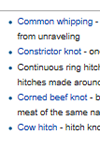The union of Shibari and Western Bondage is not an easy adventure. Where do we start from?
I suggest that we oberve what we know from knots, bondage and ropework. We shall then extend our conclusions and cross-fertilize them with simulations or theoretical schemes. This approach might result in an heterogeneous set of leads but each of them will be important. Each of them will be followed. At the end of our journey, we will understand why we had to follow them.
Let's get started.
First learning experience : "Observe"
A bondage can be closed anywhere along the rope
What are knots used for? They are used to close a rope after you have rigged something with it. Once you have tightened your knot, the rope is closed. And when a rope is closed with a suitable knot what difference does it make if it is placed here or there? In fact there is no difference! A closing knot could be placed anywhere along the rope, there would be no change in the rope path nor in the rope behavior.
 |
 |
 |
When we draw a bondage, let us forget about the closing knot. What makes a bondage different from another bondage is not the closing knot but rather the crossings of the rope onto itself. My entire work intends to help you with the infinite world of crossings.
We shall then consider any bondage as a closed loop made of a single rope. Our work shall not be to place the rope and close it with a knot, but rather define the crossings that make a given path possible; so that the final bondage fits the shape that you defined.
Few knots, wrongly tabulated
We have to aknowledge the fact that knots are not well tabulated, not even organized in the common knowledge. Their names are totally useless to riggers. One can barely find a book that uses theoretical concepts to sort and name the knots. Although many publications can help you to discover the infinite world of knots, there are no criteria that you can rely on to select one for bondage application. Let me illustrate this statement with a few examples that you can find on the web.
|
Amazon.com first result for "Knots book" |
Wikipedia.org list of knots sample |
Famous Book of knots TOC |
The above examples of books do not fulfill our requirements. Riggers cannot rely on such ranking (Fishing / Climbing / Sailing /...) or such names (Cow Hitch / Constrictor / Corned Beef / ...) to build nice bondages. We need something new here.
As our creativity strongly depends on an appropriate knots tabulation, I decided to create one. You will discover it soon enough. Just keep in mind that your reading has just started. Be patient. You will be given anything yo uneed. In particular this wonderful bondage-dedicated knots library. There is much more to come about knots and ropeworks. If you like to jump to the place, right now, click here. But I strongly suggest you to be back here to benefit from the entire journey.
It may be worth to step back a little bit and think about what knots actually are.
Even or nothing
What is a knot? Knots are nothing else than ropes entering and exiting a given volume of space.
The simplest knot would be made of 1 rope. Its shape does not matter. 1000's of such knots exist but at the end, they are all the same : Just two ends exiting on each side of this given volume of space.
We could say that those knots are not really applicable to rope bondage. Well yes, you're right.
They can still be useful though; to avoid rope sliding for example. |
 Although these knots are very simple, they teach us something really important : Rope ends always go by 2. This is actually a crucial observation.
The number of rope ends exiting from a knot is always even. Knots with only 3 rope ends do not exist. |
There are 3 elementary knots
In our day to day life, knots are a little more complex than just a single piece of rope.
Elementary knots are made of 2 ropes : 2 pieces of rope each entering and exiting the knot. Let's observe them. Their physical shapes have 2 branches.
 If you consider a knot with 2 branches, you will notice that only 3 types of knots can be achieved : A rope entering from one side has only 3 choices to exit and the other rope takes obviously the only path left from the third end to the fourth. This also means that we know a very nice way to categorize our knots : Based on the way one rope enters and exits the knot! |
|
|
How can we benefit from this result? My proposal is to name these types after the path of the rope :
We shall call a knot where ropes remain parallel "+1" and a knot where ropes cross eachother "-1". The knot where the ropes enter and exit from the same side shall ba "0". As an example, the above table contains 2 knots of every possible type : +1, 0 and -1. |
Elementary algebra
It is quite natural to connect our elementary knots and see what we can learn from this connection. As shown in this picture two elementary knots connecting eachother will result in (are equivalent to) an elementary knot. Therefore we shall try to understand the relationship between the two involved knots and the resulting one. This study is straight forward : Let's line up some combinations of two elementary knots and observe them.
 |
The resulting knot is nothing else than the product of the crossings that we combined! Although the result is completely intuitive, the fact that knots follow a mathematical rule is just incredible. Naming the knots after their crossing characteristics is extremely powerful and we shall extend this result to a wider selection of knots in the coming pages. Let us keep in mind that elementary knots obey simple formulas : 1 x -1 = -1 Click here if you want to see the complete set of rules. |
One important result from this study is also that we don't need to know the actual shape of the knots. We just need to know their crossing properties.
Let me introduce here a very useful piece of concept that you may call "Black Boxes". Knots themselves can be treated as black boxes. Which means, when you draw your bondages you don't need to select their physical shape.
What you need to select is the crossing properties of the knots. After the bondage is complete (and we shall soon apprehend the criteria that define such a bondage) you will select your physical knots from a table where all knots of types +1, 0 , -1 are stored.
The traditional shibari knot is irregular
Let us now observe the most famous shibari knots.
| Nonetheless this knot is very elegant, it is also very popular as it is very simple and protects the skin from rope burns when you tie it. But comparing it with elementary knots, we can immediately see some differences: 1/ It has 4 branches. What we learn from this observation is that irregular knots are widely used although they are pretty difficult to describe. |
 |
"A knot with n branches is regular if any of the ropes it is made of can transform into another rope by an integer number of rotations of 1/n turn."
Furthermore, it is important to notice that the rope is doubled in each of the four directions. We will keep this as an assumption until we can clearly explain why the rope has to be doubled in the next chapter.
Control your ropeworks
Let me also point out the fact that riggers only use the knots they know. I mean, riggers tend to use a toolbox but never create the tools they need to subsequently design new bondages.
This results in two possible types of ropeworks.
1/
Most of time easthetic criteria do not prevail. The bondage is driven by rigger's purpose regardless of the way the rope has to be arranged.
This method targets strong and unescapable ropeworks. It generally applies to the Damsels in Distress style.
One can also observe in eastern shibari ropeworks as well.
Resulting images carry out a powerful image of submission and sadism.
2/
In some other cases, ropeworks are driven by riggers'knowledge about knots.
The limitation is obviously the number of available knots and the level of abstraction the rigger is capable of.
When pretty knots are associated to form a bondage, the rope path is defined by the knots themselves and not by the rigger.
Therefore, the rigger's task (apart from execution) is to select the knots and study th resulting rope path until the overall ropework meets his easthetics criteria.
While in some cases the result can be very pretty, without proper preparation the rigger undergoes the rope rather than controlling it.
The very purpose of my work is to extend rigger's possibilities and control beyond anything that has existed.




